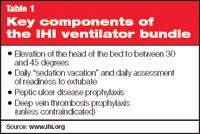Prevention is key in treating pneumonia
Preventing and treating pneumonia in critically ill patients.
Picture this: An 80-year-old patient in the intensive care unit is ventilated, sedated, and kept in a supine position-a likely setting for possible aspiration and subsequent pneumonia in this critically ill patient. For many years, mechanical ventilation has been a minefield, loaded with potential risks for critically ill patients.
In ICU patients, most hospital-acquired pneumonia (HAP) episodes usually occur during mechanical ventilation. Perhaps the most disturbing aspect of ventilator-associated pneumonia (VAP) is the high rate of associated mortality-up to 46%.
"There are several evidence-based strategies healthcare providers can implement to help prevent VAP in their patients," said Wendy Bullington, Pharm.D., clinical pharmacy specialist at Medical University of South Carolina in Charleston. She urged that clinicians be well informed of the guidelines of the American Thoracic Society (ATS) and Infectious Diseases Society of America (IDSA) for HAP and VAP management. The guidelines were published in the American Journal of Respiratory and Critical Care Medicine (AJRCCM) in 2005.
The ATS/IDSA guidelines advocate using daily interruption or lightening of sedation to decrease the duration of mechanical ventilation and thereby the risk of VAP. "Pharmacists can play a crucial role by collaborating with their hospital team and implementing a protocol that includes daily 'sedation vacation' strategy," said Bullington.
Additionally, the guidelines suggest keeping patients in the semirecumbent (30°-45°) rather than supine position to prevent aspiration. Accumulating evidence also indicates that modulation of oropharyngeal colonization by the use of chlorhexidine helps prevent VAP in select cardiac-surgical patients. A recent study, published in AJRCCM, also showed that topical oral decontamination with chlorhexidine reduced the incidence of VAP in critically ill ICU patients.

Notably, the IHI document advocates "empowering pharmacy to review orders for patients in the ICU to ensure that some form of peptic ulcer disease prophylaxis is in place at all times on ICU patients."
The art of antibiotic use
For the treatment of HAP/VAP, Bullington stressed that the major goal of the ATS/IDSA guidelines is early and appropriate use of antibiotics in adequate doses. At the same time, the guidelines also emphasize avoiding excessive antibiotics by de-escalation of initial therapy, based on microbiological cultures and clinical response of the patient, and shortening therapy duration to the minimum effective period.
Choosing the initial empiric therapy for HAP and VAP patients at risk for multidrug resistant (MDR) pathogens can be fairly complex. According to the guidelines, patients generally should be treated with an antipseudomonal cephalosporin such as cefepime (Maxipime, Bristol-Myers Squibb), or an antipseudomonal carbapenem such as meropenem (Merrem, AstraZeneca) or imipenem (Primaxin, Merck), or a beta-lactam/beta-lactamase inhibitor such as piperacillin/tazobactam (Zosyn, Wyeth), plus either an antipseudomonal fluoroquinolone such as ciprofloxacin or an aminoglycoside. For methicillin-resistant Staphylococcus aureus (MRSA) coverage, therapy with either vancomycin or linezolid (Zyvox, Pfizer) is suggested.